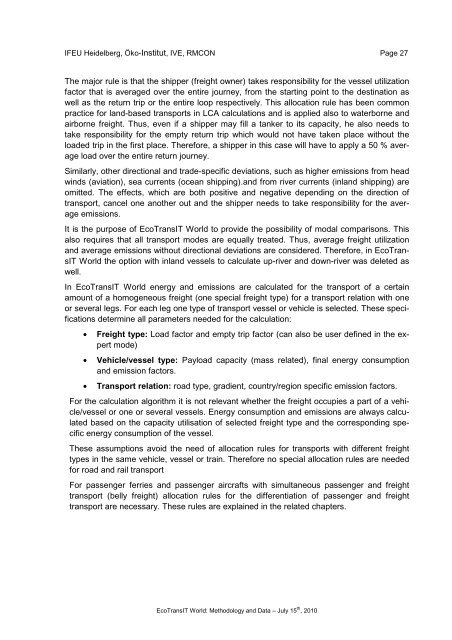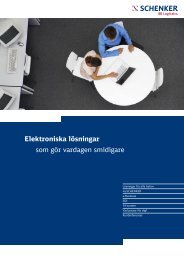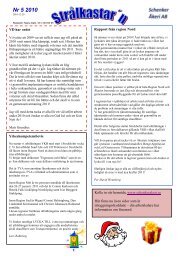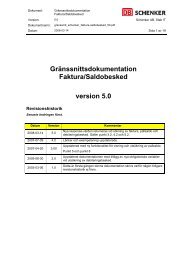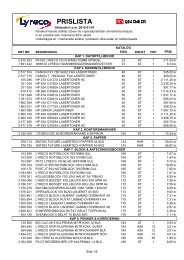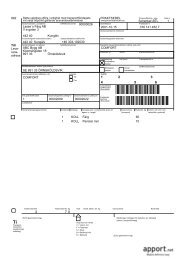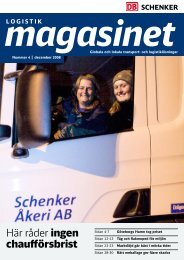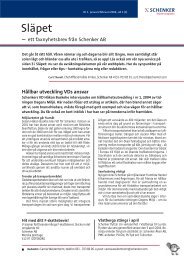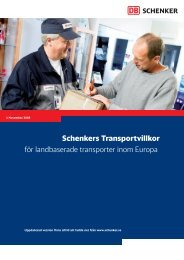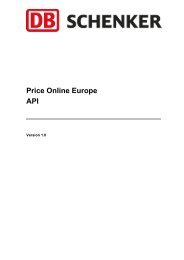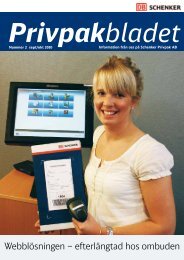Ecological Transport Information Tool for Worldwide ... - Schenker
Ecological Transport Information Tool for Worldwide ... - Schenker
Ecological Transport Information Tool for Worldwide ... - Schenker
You also want an ePaper? Increase the reach of your titles
YUMPU automatically turns print PDFs into web optimized ePapers that Google loves.
IFEU Heidelberg, Öko-Institut, IVE, RMCON Page 27<br />
The major rule is that the shipper (freight owner) takes responsibility <strong>for</strong> the vessel utilization<br />
factor that is averaged over the entire journey, from the starting point to the destination as<br />
well as the return trip or the entire loop respectively. This allocation rule has been common<br />
practice <strong>for</strong> land-based transports in LCA calculations and is applied also to waterborne and<br />
airborne freight. Thus, even if a shipper may fill a tanker to its capacity, he also needs to<br />
take responsibility <strong>for</strong> the empty return trip which would not have taken place without the<br />
loaded trip in the first place. There<strong>for</strong>e, a shipper in this case will have to apply a 50 % average<br />
load over the entire return journey.<br />
Similarly, other directional and trade-specific deviations, such as higher emissions from head<br />
winds (aviation), sea currents (ocean shipping).and from river currents (inland shipping) are<br />
omitted. The effects, which are both positive and negative depending on the direction of<br />
transport, cancel one another out and the shipper needs to take responsibility <strong>for</strong> the average<br />
emissions.<br />
It is the purpose of EcoTransIT World to provide the possibility of modal comparisons. This<br />
also requires that all transport modes are equally treated. Thus, average freight utilization<br />
and average emissions without directional deviations are considered. There<strong>for</strong>e, in EcoTransIT<br />
World the option with inland vessels to calculate up-river and down-river was deleted as<br />
well.<br />
In EcoTransIT World energy and emissions are calculated <strong>for</strong> the transport of a certain<br />
amount of a homogeneous freight (one special freight type) <strong>for</strong> a transport relation with one<br />
or several legs. For each leg one type of transport vessel or vehicle is selected. These specifications<br />
determine all parameters needed <strong>for</strong> the calculation:<br />
• Freight type: Load factor and empty trip factor (can also be user defined in the expert<br />
mode)<br />
• Vehicle/vessel type: Payload capacity (mass related), final energy consumption<br />
and emission factors.<br />
• <strong>Transport</strong> relation: road type, gradient, country/region specific emission factors.<br />
For the calculation algorithm it is not relevant whether the freight occupies a part of a vehicle/vessel<br />
or one or several vessels. Energy consumption and emissions are always calculated<br />
based on the capacity utilisation of selected freight type and the corresponding specific<br />
energy consumption of the vessel.<br />
These assumptions avoid the need of allocation rules <strong>for</strong> transports with different freight<br />
types in the same vehicle, vessel or train. There<strong>for</strong>e no special allocation rules are needed<br />
<strong>for</strong> road and rail transport<br />
For passenger ferries and passenger aircrafts with simultaneous passenger and freight<br />
transport (belly freight) allocation rules <strong>for</strong> the differentiation of passenger and freight<br />
transport are necessary. These rules are explained in the related chapters.<br />
EcoTransIT World: Methodology and Data – July 15 th , 2010


